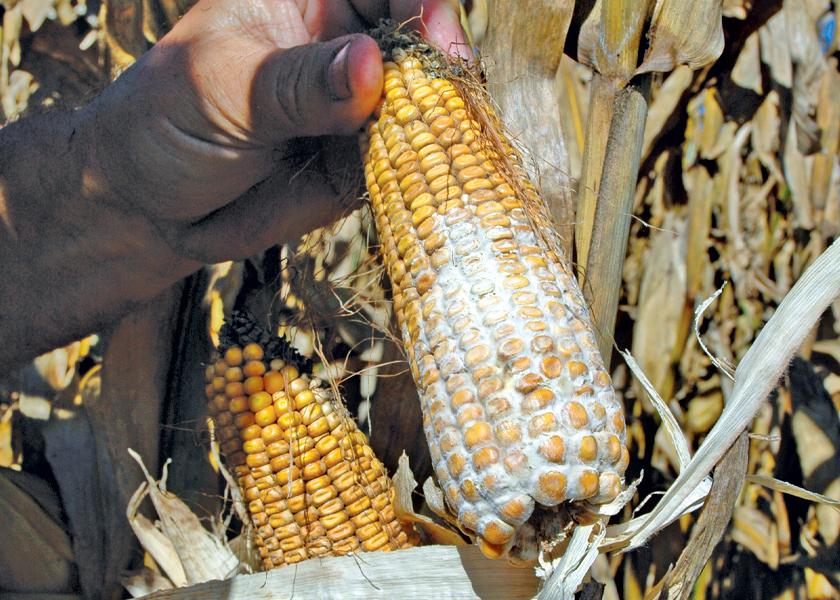U.S. Harvest Analysis Reveals Variable Mycotoxin Risk, Alltech Reports

The corn silage and corn grain crops for the U.S. in 2023 have been a “moving target” for mycotoxin risk, points out Max Hawkins, technical support manager with Alltech’s mycotoxin management team. Droughts, high rainfall and other weather events affecting the corn harvest have made it even more critical than ever to analyze mycotoxin risks across the nation.
The Alltech 2023 U.S. Harvest Analysis collected and assessed almost 450 new-crop samples from across the U.S., and the results show regional variation in mycotoxin risk. Samples showed lower risk in the upper Midwest and higher risk in the East. A combination of drought and untimely rains led to much of the risk, the report says.
Mycotoxins, produced by certain species of molds, are a concern for livestock producers. Not only can they influence feed quality and subsequent animal health, but they also can have a devastating impact on performance. To determine the most accurate representation of mycotoxin risk across the U.S., samples are collected by Alltech representatives and sent to the Alltech 37+ laboratory at the company’s headquarters in Kentucky, which can detect up to 54 individual mycotoxins, according to a release.
“Drought in the Southwest and the Western Corn Belt created distinct fumonisin risks in this region, while further eastward, late season rainfall created ideal conditions for Fusarium toxins such as type B trichothecenes to flourish,” Hawkins says in a release.
Routine monitoring of feed ingredients during storage is key. Hawkins says, “Ingredients will rarely be in better condition than when they are harvested.’’
Here are some of the key insights from the Alltech 2023 U.S. Harvest Analysis:
•Dry conditions in the West created more fumonisin risk, while the later, rain-affected harvest in the East resulted in higher levels of deoxynivalenol (DON).
•In general, the mycotoxin challenge in corn grain and corn silage is lower in 2023 than in recent years. However, there are still pockets of higher risk in the Midwest and the South.
•A surprisingly high risk of aflatoxin B1 was identified in Iowa this year. Another surprising find was Penicillium present in grains, since they are typically a concern in forages.
•A good amount of corn went into storage at 14% moisture this year. It will be crucial to monitor corn coming out of storage, as it may be at higher risk now than when it was first stored.
Corn
Mycotoxin levels were higher in the East and Midwest U.S., specifically for Fusarium mycotoxins such as deoxynivalenol (DON). Earlier harvest conditions and drier conditions in the West helped to create lower risk conditions, the report shows. However, producers in this region should be aware of a higher fumonisin risk.
Of the more than 190 new-crop corn grain samples analyzed this year, results show an average of 4.4 mycotoxins per sample, with 87% of samples having multiple mycotoxins. In addition to the DON and fumonsin risks, the report found a high level of aflatoxin B1 identified in Iowa.
Corn silage
The early growing season drought in the West negatively affected corn silage this harvest season. The stress of dry conditions followed by moisture allowed certain molds to flourish, particularly Fusarium molds. Although the risk was varied in the East, Alltech said it was overall higher.
"Feed and livestock producers are encouraged to continue to monitor and test silage in storage every 60 to 90 days. This will help inform them of the mycotoxin risk they are facing as the season progresses," Alltech says in a release. "The Alltech 2023 U.S. Harvest Analysis demonstrates that mycotoxins are an ongoing, dynamic issue that livestock producers need to manage. Although testing directly post harvest provides an overview of regional contamination patterns, what happens before the animal receives the feed — including storage conditions post harvest and feeding practices on-farm — can influence what the animal will actually be ingesting in terms of mycotoxins."
To access the complete report, as well as a series of videos that provide further species-specific insights, visit Alltech 2023 U.S. Harvest Analysis.







